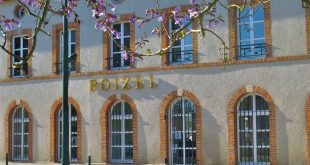

Veronique Guibert de la Vaissiere (right) is an ethnologist and specialist in the myths and traditions of Celtic Ireland. Aime Guibert, orignally from Aveyron, came from an old Millavoise family of glove and leather craftsmen.
It is believed that the vineyards of the Gassac valley go back to at least the 8th century. Saint Benoit d’Aniane, advisor to Charlemagne, is thought to have planted a vineyard there in the 780s. And offered the wine to the first king of France. It that be true, the Languedoc has had royal patronage as early as Burgundy.
Fast forward to the 20th century. In 1970, Veronique and Aime Guibert (1924 – 15 May 2016) visited the hinterland of the Herault in search of a family home. Little did they realise the seduction that was to befall them. At the bend of a path lined with pines, they fell under the spell of an old farmhouse and abandoned mill. The light was magic. The land and the house on it belonged to the Daumas family. The Gassac River watering it with life. Veronique and Aime entrusted their destiny to this newfound adventure. Everything on that day had a shimmering quality that was to change their lives and those of their children.

The winemaking and management of Mas de Daumas Gassacc has passed on to the second generationof Guiberts. On the go are brothers, from left, Roman, Samuel, Gael, and Basile (who is now based inSingapore together with his wife Marie-Alix Guibert de Grully).
Strangers to farming, the couple did not know what to plant. Was it to be corn, olive or grapes? Aime Guibert called on a friend from Aveyron, a geology professor at the University of Bordeaux whose speciality was the relationship between the soil and grapes. Henri Enjalbert (1910 – 19 June 1983) was considered the eminent specialist in wine geology. His expert opinions frequently overlapped into the fields of oenology and terroir. Sometimes also called “Bordeaux’s Most Diligent Geologist”, Enjalbert has also been described as “the Discoverer of Mas de Daumas Gassac”. His books include The History of Wine and Vine and The Origin of Quality.
Such was their friendship and regard for each other that the following year, 1971, Enjalbert came south to visit Mas de Daumas Gassac. The geology specialist spent several hours walking the valley to survey the landscape. He came backfull of enthusiasm. Professor Enjalbert informed that the soil consisted of glacial grezes, comparable to the best terroirs of the famous Golden Slope or Cote d’Or of Burgundy. Bordeaux’s most respected geologist pronounced that “a great wine can be created here but it will take perhaps 200 years for it to be recognized and accepted as such!”.
The new owners of Mas de Daumas Gassac were hanging on to every syllable spoken by the soil scholar. When the expression “Grand Cru” was used to describe the potential of the future vineyard, Veronique and Aime Guibe knew that their destiny was revealed.
Enjalbert came to the conclusion that Daumas Gassac possesses a unique terroir to produce an exceptional red wine because of the underground sources of cold water and the influence of the surrounding Arboussas and Larzac massifs, blessing the valley with a unique micro-climate. Here is a privileged terroir cocooned from the excesses of the Languedoc, particularly the heat and high temperatures. Time waits for no woman nor man. The next year, 1972, Veronique and Aime Guibert planted their first cabernet sauvignon. Being wise and far-sighted, they knew that uniformity is the enemy of quality. So, instead of getting plant material from a single source – which would had been so convenient – they bought different vines from a many top Bordeaux estates. The selection was based on quality and diversity, not on high yield and resistance to disease.

The vineyards of Mas de Daumas Gassac are organic.
Between 1972 and 1978, the Guiberts also started the building of a winery and a vat room on the site of an ancientGallo-Roman mill. Having visited Mas de Daumas Gassac I can vouchsafe that it is very cool – and constant – thereeven during summer because underneath are cold water springs from the Gassac River
In 1978, on September 13th, Emile Peynaud (29 June 1912 – 18 July 2004), perhaps the greatest oenologist of his time and the world’s first consultant winemaker, visited Mas de Daumas Gassac. Just as Henri Enjalbert taught at the University of Bordeaux, so did Peynaud, who was even more famous because he was consultant to the likes of Chateau Margaux, Lafite, Latour, Leoville Las Cases, and more. Following his visit, Emile Peynaud went back to Bordeaux to resume his teaching at the university and consultancy work for the chateaux of Bordeaux. But, he had agreed to consult for Mas de Daumas Gassac. For free. Via the telephone (the mobile phone was not yet invited then).
When journalists asked why he was willing to consult for an unknown, obscure area – Aniane – in the Languedoc, Emile Peynaud replied, “I advise the greatest French wines but, for the first time, I was lucky to witness the birth of a Grand Cru”. And so it has remained. Mas de Daumas Gassac, the Grand Cru of the Languedoc.


